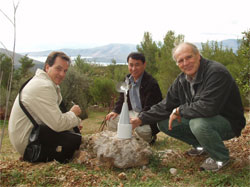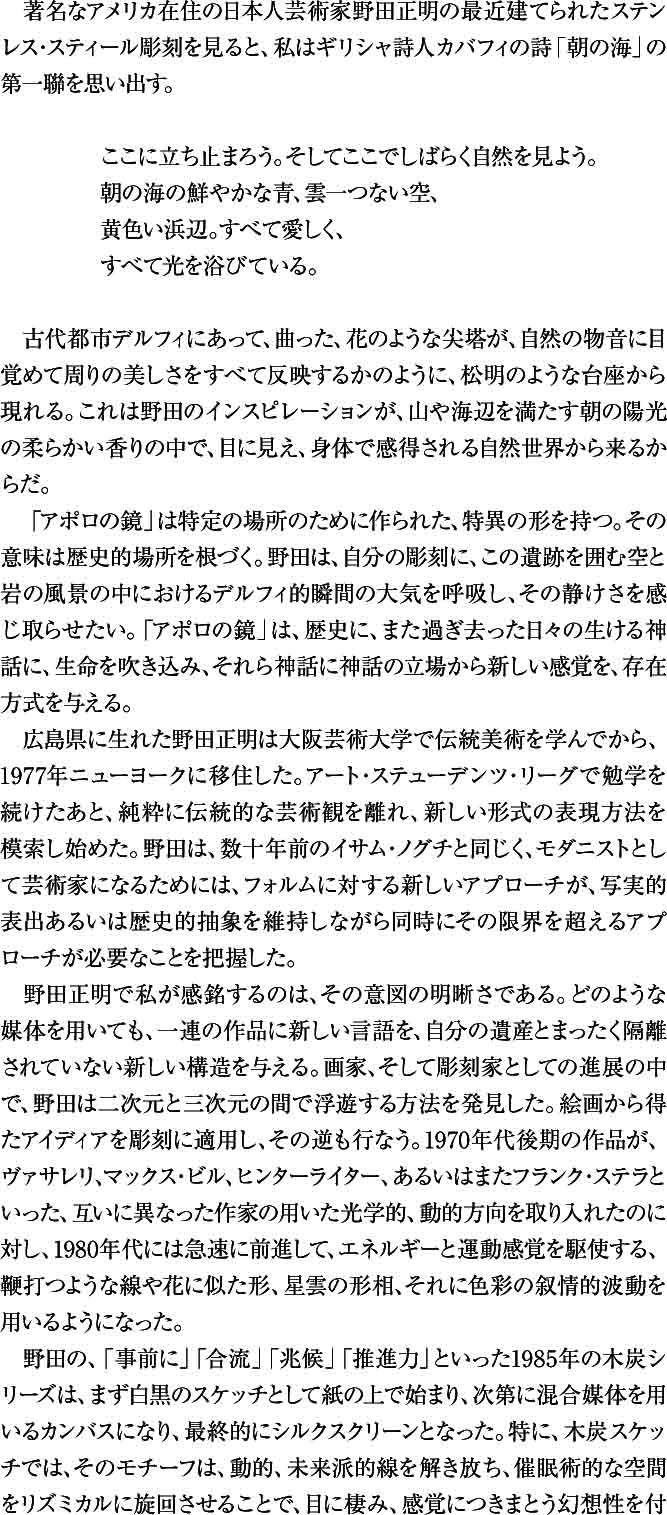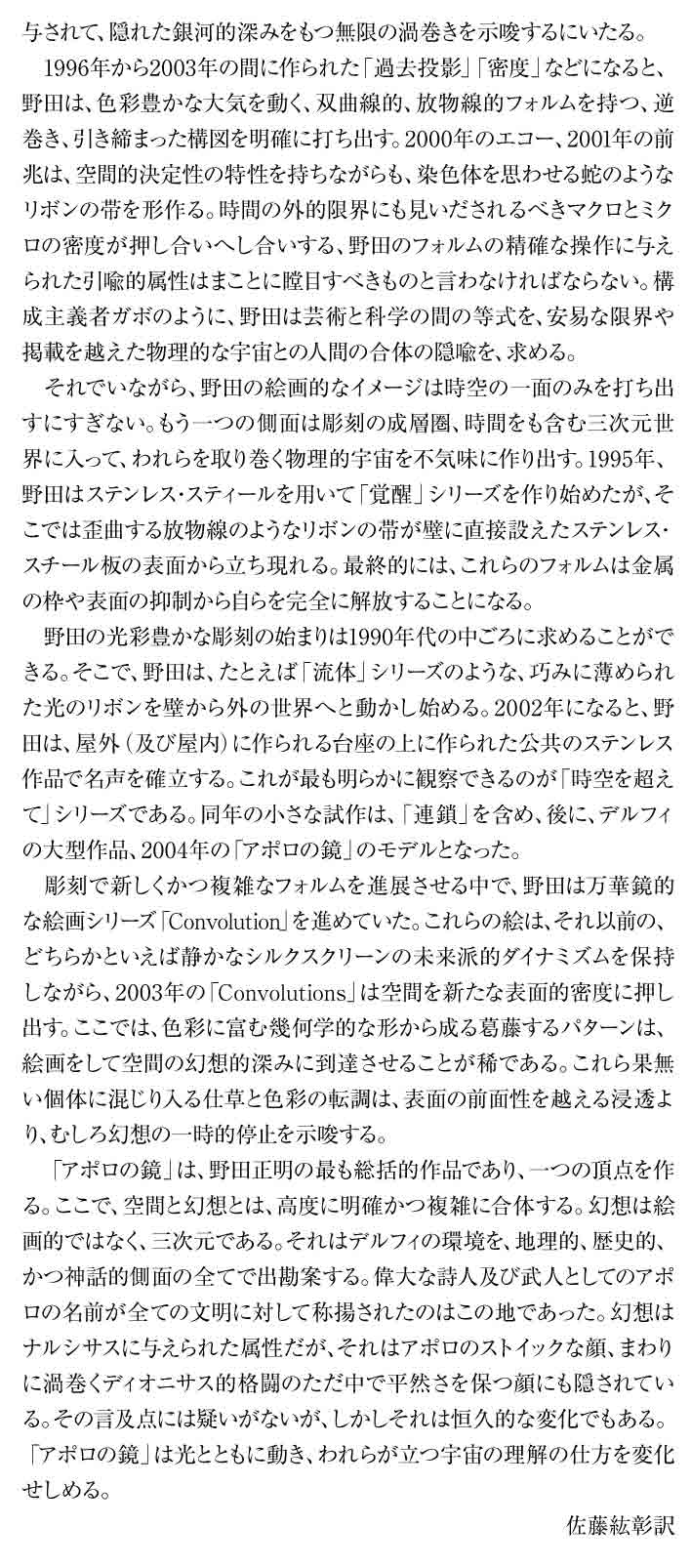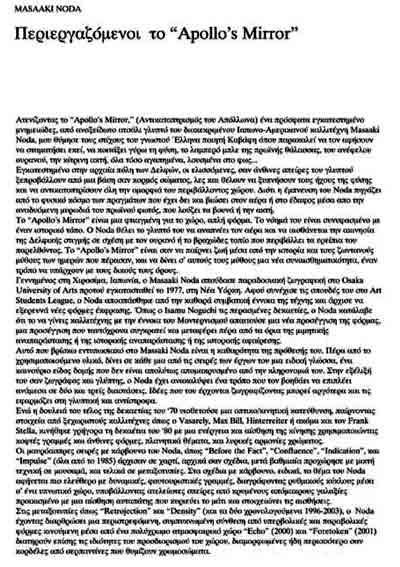MASAAKI
NODA
APOLLO'S MIRROR
DEDICATION 26 FEBRUARY 2005
EUROPEAN CULTURAL CENTER
DELPHI, GREECE

Masaaki Noda:
Circumventing “Apollo’s Mirror”
Robert C. Morgan
As I gaze at “Apollo’s Mirror”, a recently installed monumental
stainless steel sculpture by the eminent Japanese-American artist, Masaaki
Noda, I am reminded of a stanza from the famous Greek poet, Cavafy:
Let me stop here. Let me, too, look at nature awhile.
The brilliant blue of the morning sea, of the cloudless sky,
the yellow shore: all lovely,
all bathed in light.*
Located in the ancient city of Delphi, the sculpture’s twisting,
floral spires emerge from a torch-like base, as if to awaken the sounds
of nature and reflect all the beauty that surrounds it. For Noda’s
inspiration comes from the natural world of things seen and experienced
in the air or on the ground through the vaporous scent of morning light,
bathing the mountains or the seaside.
“Apollo’s Mirror” is a site-specific, singular form. Its
meaning is embedded in an historic place. Noda wants his sculpture to
breathe the air and to feel the stillness of the Delphic moment in relation
to the sky or the rocky landscape that surrounds the ruins of the past.
“Apollo’s Mirror” is about breathing life into history
and into the living myths of days gone by, and to give these myths a new
sensibility, a manner of being on their own terms.
Born in Hiroshima Prefecture, Japan, Masaaki Noda studied traditional
painting at the Osaka University of Arts before moving to New York City
in 1977. After continuing his studies at the Art Students League, Noda
broke free from the purely conventional notion of art and began to explore
new forms of expression. Like Isamu Noguchi in decades past, Noda understood
that to become an artist in the Modernist sense requires a new approach
to form, an approach that simultaneously retains yet goes beyond the limits
of mimetic representation or historical abstraction.
What I find impressive about Masaaki Noda is the clarity of his intention.
Regardless of the medium, he gives each series of work a special language,
a new kind of structure that is not entirely removed from his heritage.
In his evolution as a painter and sculptor, Noda has discovered a means
whereby he can float between two and three dimensions. Ideas that come
to him through painting may later apply to sculpture, and vice versa.
While his work in the late seventies appropriated an optical/kinetic direction,
borrowing from artists as distinct as Vasarely, Max Bill, Hinterreiter,
or even Frank Stella, he quickly moved forward in the eighties with an
energy and kinesthesia, using whiplash lines and floral forms, constellular
themes, and lyrical cadences of color.
Noda’s black and white charcoal series, such as “Before the
Fact”, “Confluence”, “Indication”, and “Impulse”
(all from 1985) began on paper, first as drawings, then gradually shifting
to mixed media on canvas, and eventually to silkscreen prints. In the
charcoal drawings, especially, Noda’s motif lets loose with dynamic,
futurist lines, circling rhythmically through hypnotic space, suggesting
an infinite vortex of hidden galactic depths, endowed with an illusionism
that inhabits the eye and haunts the senses.
In prints such as “Retrojection” and “Density” (both
dated 1996 - 2003), Noda has articulated a swirling, compact composition
of hyperbolic and parabolic forms moving through a colorful atmospheric
space. “Echo” (2000) and “Foretoken” (2001) also hold
the properties of spatial determinacy, yet shaped more like serpentine
ribbons reminiscent of chromosomes. ?e metaphorical attributes given to
Noda’s precise manipulation of form, pushing and pulling between
micro and macro densities found in the outer limits of time and space
are truly remarkable. As with the Constructivist Gabo, Noda is seeking
the equation between art and science, the metaphor of human identity with
a physical universe that exceeds facile limits or calculations.
Yet Noda’s pictorial images offer only one aspect of time and space.
Another goes into the stratosphere of sculpture, a three-dimensional world
that also includes time, thus emitting an eerie simulation of the physical
universe that surrounds us. In 1995, working with stainless steel, Noda
begin the “Awakening” series in which his twisting parabolic
ribbons emerges from the surface of a welded stainless steel plate, mounted
directly on the wall. Eventually these forms would liberate themselves
entirely from the confines of their metal frames and surfaces.
The beginning of Noda’s luminary sculpture begins in the mid-nineties
as he moves his deftly attenuated ribbons of light -- the “Fluid”
series, for example -- from the wall to the outside world. By 2002, Noda
had established a reputation for his public-scale, outdoor (and indoor)
stainless works on pedestals. ?is is most clearly observed in his “Perpetual
Light” series. His small studies from that year, including “Nexus,”
would eventually become the model for his larger scale work in Delphi,
“Apollo’s Mirror” (2004).
As Noda continued to evolve new and complex forms in sculpture, he was
also developing his kaleidoscopic “Convolution” paintings. While
these pictures retain the futurist dynamism from some of the earlier,
more muted silkscreens, the “Convolutions” (2003)push the space
towards a new kind of surface density. ?e conflicting patterns of the
colorful geometric shapes rarely allow the picture to reach into an illusionist
depth of space. ?e gestural pours and color modulations that intertwine
with these ethereal solids suggests a suspension of illusion rather than
a penetration beyond the frontality of the surface.
It could say that “Apollo’s Mirror” is truly one of Masaaki
Noda’s most comprehensive and culminating works. It is here that
space and illusion come together in a highly articulate and complex way.
?e illusion is not pictorial, but three-dimensional. It takes into account
the environment of Delphi on all levels --geographical, historical, and
mythic. It was here that the name of Apollo, the great poet/warrior, was
proclaimed for all of civilization to know. Illusion is an attribute given
to Narcissus, but it is also hidden within the stoic face of Apollo --
the face that holds steady amid all the Dionysian strife that is hurled
about it. ?e point of reference is unequivocal, and yet, it is in constant
change. “Apollo’s Mirror” moves with the light and alters
how we understand the space on which we stand.
* C.P. Cavafy:Collected Poems (Rev. Ed.), Trans. Edmund Keeley and Philip
Sherrard. Edited by George Savidis. Princeton University Press, 1992,
p. 58.
Robert C. Morgan is an internationally known writer, critic, and curator.
He holds a graduate degree in Sculpture and a doctorate in art history.
He is the author of several books on contemporary art and artists. He
live in New York City where he lectures at the School of Visual Arts and
Pratt


